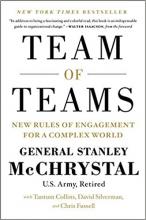1) What is your suggestion about?
General Stanley McChrystal led US Special Forces in the Middle East and then was commander of all allied forces in Afghanistan. He learned fighting terrorist networks and insurgencies that combat in the 21st century is more connected, faster paced, and less predictable than at any time in history.
Organizations and their leaders have to adapt and respond quickly in a coordinated manner and with a clear sense of purpose if they want to effect change or even survive.
Traditional organizations – defined by rigid “stovepipes” or “silos” – do not succeed in this era. Instead, he argues that success requires a more nimble “Team of Teams” approach, thus the title of the book. This is where the best of different organizations share information and are integrated together into a single, dynamic effort. His overarching theme is that to become a “team of teams,” organizations need to have shared consciousness to attain their goals. Over the many trips during the last 14 years to Iraq working with colleagues, I have seen firsthand the challenges that General McChrystal writes about.
2) Why did you choose it?
Large complex organizations are subject to what J.D. Vance, in Hillbilly Elegy, calls “learned helplessness”: this is where a history of failure leads someone to give up trying to change. Another way to look at this is that government organizations are like a big ship with a small rudder. It is hard to change direction. Therefore, people just do what they did the day before.
General McChrystal argues from his experiences for the importance of shared purpose and empowering people at all levels. Dynamic communication among teams enables them to execute in real time, learn, adapt, change, and overcome learned helplessness.
3) What else do you want to tell us about it?
Our entire leadership team at DHSS just finished reading Team of Teams. We concluded together that Missouri’s shared consciousness can be improved. We all know from experience how, in government, very narrowly directed funding can create and reinforce creates silos. And these silos focus people on their own work with a form of tunnel vision.
But we face complex challenges, such as combating the opioid crisis, that traditional department boundaries. Our solutions will likely involve a “team of teams” working together to solve such problems. No single leader can develop such solutions. In such situations, leaders should inspire, coach, and encourage, but not slow their teams down with an authoritative leadership approach. Rather, engage, empower, execute.
4) What is a key takeaway for leaders driving improvement in how we deliver for the citizens of Missouri?
To serve better the people of Missouri, we need to reinforce a shared consciousness around Governor Parson’s two policy priorities – building the workforce and infrastructure Missouri needs to succeed today and in the years ahead. To do that, we need to change the way we work every day. By focusing upon these goals, we can empower teams to work together regardless of organization charts and take initiative with a bias to action.
Governor Parson has asked us as a Cabinet to help him get Missouri to a higher level so that we make Missouri better for the next generation that follows us. With the common purpose of improving our workforce and infrastructure, each of us becomes part of the solution of making Missouri a better place for our children and grandchildren.



Comments